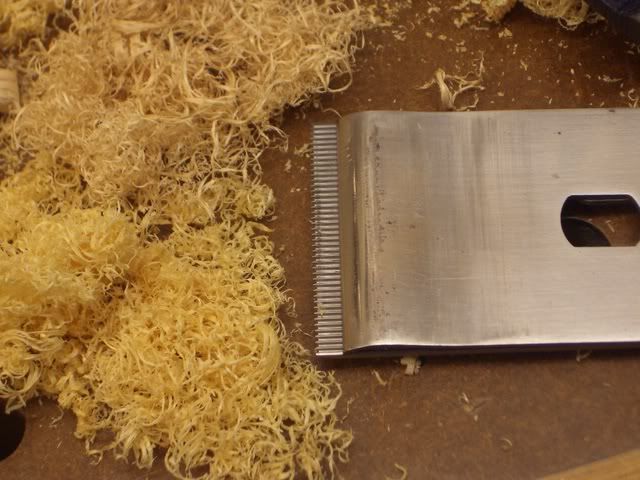I just acquired a Footprint No.4 plane for £3, I don't use metal planes as my standard bench planes and already have a No.4 anyway... But I'm an avowed fan of Footprint tools and the seller was going to bin it if it didn't sell, all for a bit of surface rust and want of some oil on the wooden parts! 
My existing No.4 has an iron with a back-bevel on it for a higher angle to smooth awkward timbers; I feel a toothing plane would complement that nicely!
I know that toothed bailey-pattern irons are available, but if i understand correctly, a toothing plane ideally have a higher effective cutting angle than the standard 45-50 degrees, to minimise the risk of the teeth digging in.
I have thought up some possible solutions to this:
Of the three, the first* appeals because it's free and easy, but I'm likely to kick myself if I end up using it a lot and have to re-cut the teeth midway through something.
I'm not entirely sure the second is possible, as I'm pretty sure that I'd need a longer screw for the lever cap, and would either have to drill a new hole/mill an extension the the slot in the lever cap or position it a little further up on the iron-chipbreaker assembly and hope that it doesn't then allow the iron to chatter in the cut.
Any opinions on my proposed solutions, or suggested alternative solutions most welcome.
*Rather than a solution, that's more of a "system" to work around the problem; being that a solution to a problem is final, but the second law of thermodynamics dictates that all systems tend towards disorder.
My existing No.4 has an iron with a back-bevel on it for a higher angle to smooth awkward timbers; I feel a toothing plane would complement that nicely!
I know that toothed bailey-pattern irons are available, but if i understand correctly, a toothing plane ideally have a higher effective cutting angle than the standard 45-50 degrees, to minimise the risk of the teeth digging in.
I have thought up some possible solutions to this:
- Rather than buy a toothed iron, which can't be back-beveled, clean up the existing one in the plane, sharpen a back bevel onto it, and then cut teeth into the edge with a needle file and re-dress the edge gently
- Buy a "proper" toothed iron, and make a wedged hardwood shim to sit on the frog for a higher cutting angle.
- Buy a toothed iron, fit it and hope it's effective enough at the normal angle.
Of the three, the first* appeals because it's free and easy, but I'm likely to kick myself if I end up using it a lot and have to re-cut the teeth midway through something.
I'm not entirely sure the second is possible, as I'm pretty sure that I'd need a longer screw for the lever cap, and would either have to drill a new hole/mill an extension the the slot in the lever cap or position it a little further up on the iron-chipbreaker assembly and hope that it doesn't then allow the iron to chatter in the cut.
Any opinions on my proposed solutions, or suggested alternative solutions most welcome.
*Rather than a solution, that's more of a "system" to work around the problem; being that a solution to a problem is final, but the second law of thermodynamics dictates that all systems tend towards disorder.

































